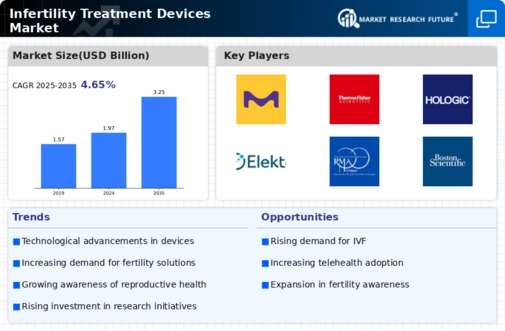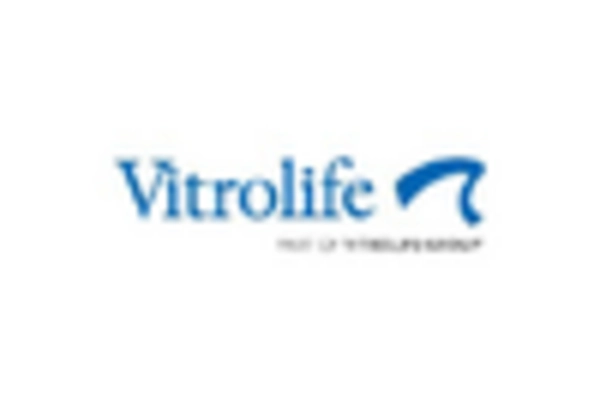Rising Awareness and Education
Rising awareness and education regarding infertility issues are driving the Infertility Treatment Devices Market. Increased public discourse about reproductive health, coupled with educational campaigns, is helping to destigmatize infertility and encourage individuals to seek treatment. Healthcare professionals are also playing a crucial role in educating patients about available options, which is likely to lead to higher adoption rates of infertility treatment devices. As more individuals become informed about the causes and solutions for infertility, the demand for advanced treatment technologies is expected to rise. This trend is further supported by the proliferation of online resources and support groups, which provide valuable information and foster community engagement. Consequently, the Infertility Treatment Devices Market is poised for growth as awareness continues to expand.
Personalized Treatment Approaches
The shift towards personalized treatment approaches is emerging as a key driver in the Infertility Treatment Devices Market. Tailoring treatments to individual patient needs enhances the likelihood of successful outcomes, thereby increasing patient satisfaction. Advances in genetic testing and biomarker identification are enabling healthcare providers to customize infertility treatments based on specific patient profiles. This trend is likely to lead to the development of more targeted devices and therapies, which could improve overall treatment efficacy. As personalized medicine gains traction, the Infertility Treatment Devices Market is expected to evolve, with a growing emphasis on individualized care. This approach not only addresses the unique challenges faced by patients but also aligns with broader healthcare trends towards precision medicine.
Government Initiatives and Support
Government initiatives and support play a significant role in the growth of the Infertility Treatment Devices Market. Many countries are implementing policies aimed at improving access to fertility treatments, including subsidies and funding for research and development. For example, some governments are offering financial assistance to couples undergoing infertility treatments, which is likely to increase the utilization of advanced devices. Furthermore, regulatory bodies are streamlining the approval processes for new infertility treatment technologies, encouraging innovation and market entry. This supportive environment is expected to foster growth in the Infertility Treatment Devices Market, as more companies are incentivized to develop and introduce cutting-edge solutions to meet the rising demand.
Increasing Incidence of Infertility
The rising incidence of infertility is a critical driver for the Infertility Treatment Devices Market. Factors such as delayed childbearing, lifestyle changes, and environmental influences contribute to this trend. According to recent statistics, approximately 15% of couples worldwide face infertility issues, which has led to a heightened demand for effective treatment solutions. This growing prevalence is prompting healthcare providers to invest in advanced infertility treatment devices, thereby expanding the market. Additionally, the increasing number of fertility clinics and specialized centers is likely to facilitate access to these devices, further propelling market growth. As awareness of infertility issues continues to rise, the Infertility Treatment Devices Market is expected to witness sustained demand for innovative treatment options.
Technological Advancements in Infertility Treatment Devices
The Infertility Treatment Devices Market is experiencing a surge in technological advancements that enhance treatment efficacy and patient outcomes. Innovations such as advanced imaging techniques, robotic-assisted surgeries, and artificial intelligence-driven diagnostics are becoming increasingly prevalent. For instance, the integration of AI in embryo selection has shown to improve success rates significantly. The market is projected to grow at a compound annual growth rate of approximately 8% over the next few years, driven by these technological innovations. Furthermore, the development of minimally invasive procedures is likely to reduce recovery times and improve patient satisfaction, thereby attracting more individuals to seek treatment. As these technologies continue to evolve, they are expected to play a pivotal role in shaping the future landscape of the Infertility Treatment Devices Market.


















Leave a Comment